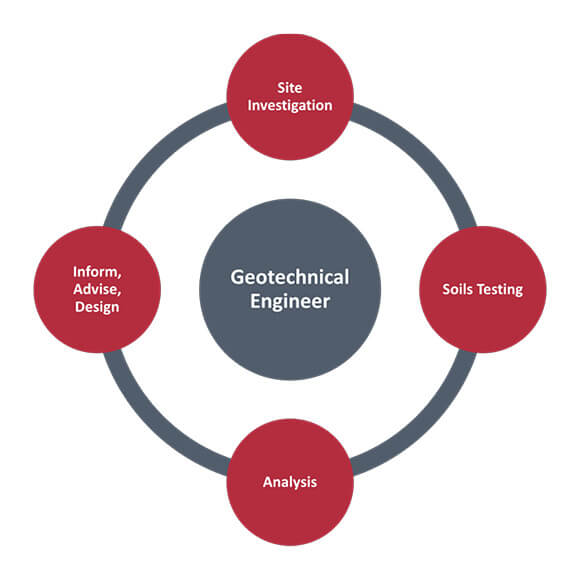How Geotheta can Save You Time, Stress, and Money.
How Geotheta can Save You Time, Stress, and Money.
Blog Article
The Best Strategy To Use For Geotheta
Table of ContentsSome Known Facts About Geotheta.Fascination About GeothetaThe Buzz on GeothetaGeotheta Fundamentals ExplainedIndicators on Geotheta You Need To Know

They conduct site investigations, accumulate samples, perform laboratory examinations, and assess data to examine the viability of the ground for construction projects - Tailings Engineer. Based on their findings, geotechnical engineers provide referrals for structure style, slope stability, retaining frameworks, and reduction of geotechnical hazards. They collaborate with other professionals, such as engineers, structural designers, and building teams, to make certain that geotechnical factors to consider are integrated into the overall job design and execution
By analyzing the actions and properties of dirt and rock, they can identify possible geotechnical risks such as landslides, dirt negotiation, or slope instability. Their experience assists prevent failures or mishaps that might threaten lives and residential or commercial property. Right here are some detailed obligations and responsibilities of a geotechnical engineer: Site Investigation: Geotechnical engineers conduct website investigations to collect data on subsurface conditions.
They analyze the data to recognize the residential properties and actions of the soil and rock, including their stamina, permeability, compaction attributes, and groundwater problems. Geotechnical Evaluation and Style: Geotechnical designers analyze the information collected during website examinations to analyze the stability and viability of the site for building and construction projects. They carry out geotechnical computations and modeling to examine aspects such as bearing ability, settlement, slope stability, side earth pressures, and groundwater flow.
The Ultimate Guide To Geotheta
Structure Design: Geotechnical designers play a crucial function in designing foundations that can securely support the intended framework. They examine the soil problems and load demands to figure out the suitable foundation kind, such as shallow structures (e.g., footings), deep structures (e.g (https://www.metal-archives.com/users/geotheta)., stacks), or specialized techniques like dirt renovation. They consider variables such as negotiation limits, bearing ability, and soil-structure interaction to develop ideal structure styles
They evaluate building plans, display website tasks, and conduct area inspections to verify that the design suggestions are complied with. If unpredicted geotechnical issues arise, they analyze the circumstance and give recommendations for removal or changes to the style. Risk Analysis and Mitigation: Geotechnical engineers examine geotechnical threats and risks linked with the task site, such as landslides, liquefaction, or dirt erosion.

Collaboration and Interaction: Geotechnical engineers function very closely with various other specialists entailed in a task, such as architects, structural designers, and building and construction teams. Efficient interaction and partnership are important to integrate geotechnical factors to consider right into the total job design and building and construction process. Geotechnical designers supply technical knowledge, response queries, and make sure that geotechnical demands are met.
Geotheta Things To Know Before You Get This
Below are some kinds of geotechnical engineers: Structure Engineer: Structure designers concentrate on designing and analyzing foundations for structures. They analyze the dirt conditions, tons needs, and website features to establish the most proper foundation type and layout, such as superficial foundations, deep structures, or specialized strategies like stack structures.
They assess the variables influencing incline security, such as soil residential properties, groundwater problems, and slope geometry, and establish methods to stop slope failings and minimize dangers. Earthquake Engineer: Earthquake designers concentrate on analyzing and designing structures to stand up to seismic forces. They examine the seismic risk of a site, review dirt liquefaction possibility, and establish seismic design requirements to ensure the security and durability of frameworks during earthquakes.
They carry out area screening, accumulate examples, and assess the gathered data to characterize the soil residential or commercial properties, geologic formations, and groundwater conditions at from this source a website. Geotechnical Instrumentation Designer: Geotechnical instrumentation designers concentrate on monitoring and determining the behavior of soil, rock, and frameworks. They set up and preserve instrumentation systems that check aspects such as dirt negotiation, groundwater degrees, slope activities, and architectural variations to examine efficiency and offer early cautions of possible problems.
The Basic Principles Of Geotheta
They conduct examinations such as triaxial tests, loan consolidation examinations, straight shear tests, and permeability examinations to collect data for geotechnical analysis and layout. Geosynthetics Designer: Geosynthetics engineers focus on the design and application of geosynthetic products, such as geotextiles, geogrids, and geomembranes. They use these products to improve dirt security, enhance slopes, supply drain remedies, and control erosion.
They have a tendency to be investigative people, which suggests they're intellectual, introspective, and curious. They are curious, methodical, reasonable, analytical, and logical. Some of them are likewise social, meaning they're kind, generous, cooperative, person, caring, practical, understanding, sensible, and friendly - Consulting Engineer.
In the office setting, geotechnical engineers use specialized software program tools to perform computations, produce layouts, and analyze data. They prepare reports, evaluation task specifications, interact with customers and team members, and coordinate job tasks. The office setting gives a favorable environment for study, evaluation, and collaboration with other experts included in the task.
What Does Geotheta Do?
They often go to task sites to carry out site examinations, examine geotechnical conditions, and collect information for analysis. These sees include taking a trip to various places, in some cases in remote or challenging surfaces. Geotechnical engineers might execute dirt tasting, conduct examinations, and screen construction activities to ensure that the geotechnical aspects of the task are being implemented correctly.
Geotechnical engineers also operate in specialized geotechnical research laboratories. In these facilities, they perform experiments, perform examinations on dirt and rock examples, and assess the engineering properties of the products. Geotechnical research laboratory engineers work extensively in these environments, managing screening devices, operating tools, and recording information. They work together with various other research laboratory team to ensure precise and reputable screening results.
Report this page